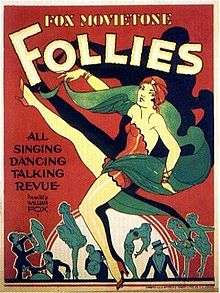Fox Movietone Follies of 1929
| Fox Movietone Follies of 1929 | |
|---|---|
 theatrical release poster | |
| Directed by | David Butler and Marcel Silver |
| Produced by | William Fox |
| Written by |
David Butler William K. Wells |
| Starring |
Sue Carol Sharon Lynn Dixie Lee Lola Lane |
| Music by | Arthur Kay |
| Cinematography | Charles Van Enger |
| Edited by | Ralph Dietrich |
Production company | |
| Distributed by | Fox Film Corporation |
Release dates | May 26, 1929 |
Running time | 80 minutes |
| Country | United States |
| Language | English |
Fox Movietone Follies of 1929, also known as Movietone Follies of 1929 and The William Fox Movietone Follies of 1929, was a black-and-white and color American musical film released by Fox Film Corporation.
Plot
George Shelby, a southern boy, comes to the city to dissuade Lila, his sweetheart, from embarking on a stage career and finally buys out the controlling interest in the revue so that he can fire her. On the opening night, however, she goes onstage when the prima donna of the show becomes temperamental, and she proves to be a big hit. At this development, George is able to sell the show back to the producer, who had previously lacked confidence in his investment and planned to take advantage of the youth's inexperience.
Cast
- John Breeden as George Shelby
- Lola Lane as Lila Beaumont
- De Witt Jennings as Jay Darrell
- Sharon Lynn as Ann Foster
- Arthur Stone as Al Leaton
- Stepin Fetchit as Swifty
- Warren Hymer as Martin
- Archie Gottler as Stage Manager
- Arthur Kay as Orchestra leader
- Mario Dominici as Le Maire
Soundtrack
All songs were written by Con Conrad, Archie Gottler and Sidney D. Mitchell.
- "Walking With Susie"
- "Why Can't I Be Like You?"
- "Legs"
- "Breakaway"
- "That's You Baby"
- "Look What You've Done To Me"
- "Big City Blues"
- "Pearl of Old Japan"
Production
Filming locations for Fox Movietone Follies of 1929 included Havana, New York City, and Palm Beach, Florida.
Preservation status
The film had Multicolor sequences in its original release, as well as being filmed in the experimental Grandeur wide-screen process. It is now considered a lost film,[1] as all film prints known to exist were destroyed in fires at the Fox storage facility in New Jersey in 1937. The sequel, New Movietone Follies of 1930, also has Multicolor sequences and exists in the UCLA Film and Television Archive.[1]
See also
References
External links
- Surviving Vitaphone soundtrack disk at SoundCloud
- Fox Movietone Follies of 1929 at the Internet Movie Database
- New York Times
- OV Guide
- Variety